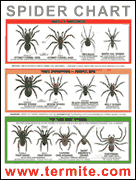| Pest Control - Fleas - Flea Control |
|
|||
Blood suckers: Fleas pierce the skin, inject an anti-coagulant chemical into the bloodstream of the host to prevent blood clotting. YUCK but true: When fleas suck the blood from their host, some of the blood passes directly through their rectum in order to lay their eggs. Tapeworms: A flea bite can cause acute irritation, infection and transfer of other parasites, including tapeworms. For irritable flea bites consult your pharmacist for an appropriate antiseptic cream or in more serious situations, your medical practitioner. Dogs and cats: Fleas often enter a building on dogs and cats, and are commonly deposited in carpeted areas, in the garden, yard and under the building, particularly shaded sandy soil ares, on the southern side of the building (shaded areas). Dormant in your carpets: In ideal hot humid weather, flea eggs may take only a few weeks to hatch in large numbers. In cooler times of the year, the flea eggs may lay dormant in carpets and subfloor areas for more than 12 months before hatching - generally during hot humid weather and all of a sudden, sometimes in plague proportions. Summer holidays and you're the HOST: A uninhabited home that has been locked up for an extended period during hot humid weather, will act as an incubator for the dormant fleas to hatch in plague proportions. It is common-place for people who own a dog or cat, to return home from an extended summer vacation to find a house full of fleas. |
|||
Insecticide treatment: In severe cases, there may be no practical alternative to insecticide treatment of likely habitat areas, particularly low traffic areas of carpeting, around the edges of timber flooring and dog or cat resting areas. We recommend a low hazard IGR synthetic pyrethroid insecticide be applied as a light spray to such areas, and upon drying be swept into the carpet pile with a straw broom. IGR Insect Growth Regulator is a ultra low hazard chemical that acts specifically to inhibit development of the flea at the larva stage of their life cycle. The flea larva is a small "grub" that lives in carpet, in cracks or joins of timber flooring and in soil areas. A readily accessible supply of organic matter, such as shed skin flakes from humans, is essential for it's development. This is the critical point in the life cycle of the flea in which to attack it for maximum control effect on the infestation. With a heavy infestation of adult fleas the affected rooms should be fumigated with a similar insecticide dispensed through a fogging machine. This will provide immediate relief (like a flea "bomb") but with not kill the larva or egg sacs. The carpets and other areas should be treated as noted above with an IGR synthetic pyrethroid insecticide. To help prevent reinfestation we recommend the home owner regularly vacuum carpets; regularly wash your dog or cat with shampoo containing a flea control product; and restrict access of your dog or cat to any sub-floor areas, particularly during the humid summer months. If your dog or cat regularly plays with stray dogs or cats then the transfer of fleas eggs is virtually certain during the hot humid months of the year. |
|||
 |
The cost for professional pest control for fleas will depend upon many factors, including type of insecticide used, the size of the property, the extent of infestation and ease of access to sub-floor areas. FUMAPEST uses the safer, but more expensive pyrethroid insecticides.
Expect to pay about $250 to $350 for an average size 3 bedroom home, with a small to medium garden area. Service warranty periods may vary depending upon the circumstances and risk of reinfestation. |
Ring the flea control experts: successful no-hassle flea control depends largely upon the skill of the technician, their technical training and practical experience in a wide variety of situations. Contact FUMAPEST on 1300 241 500 for a FREE quote and specifications for our professional flea control service. Beware you may find cheaper prices for flea control in your local area, usually from companies using the cheaper solvent based pesticides in and around the home, which we do NOT recommend, especially if residents suffer asthma or bronchial ailments. Ask for a discount if you also wish to obtain a termite inspection report to AS 3660 at the same time as flea control. If a combined service is done on the same day, the cost of such an inspection and report to AS 3660 will be discounted accordingly. REMEMBER home insurance does NOT cover termite damaged timbers in your home .... for more details. Be careful when selecting a pest controller - it is far too easy to get a NSW WorkCover Pest Control licence and start up a pest control business, using trainees with little knowledge or experience in flea control situations .... for more details. |
||
 |
FREE - FUMAPEST Spider Identification Chart with FIRST AID spider bite procedures - a ready reference guide in full colour of dangerous and venomous spiders that commonly occur in the <%=strCouncil %> Council region.
Featured in the Spider Identifcation Chart are the male and female Sydney funnel web spider, red-back spider, white-tail spider, black house spider, wolf spider, mouse spider, trap-door spider, huntsman spider, orb-weaver spider and other spiders with notes to aid in spider identification.
|
|||
|
|||||||||||||||||||||||||||||||||||||||||||||||||||||||||||||||||||||||||||||
                |



